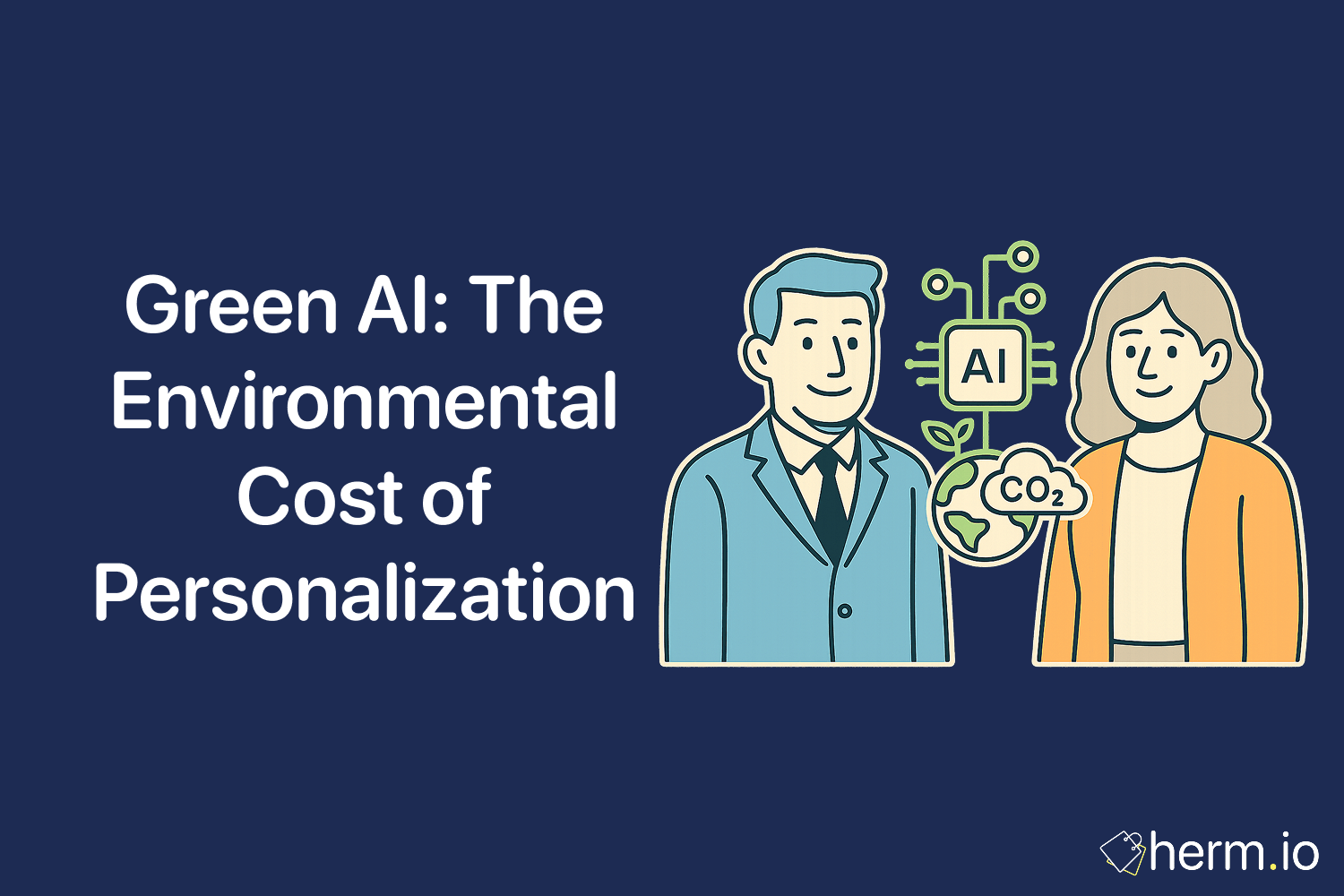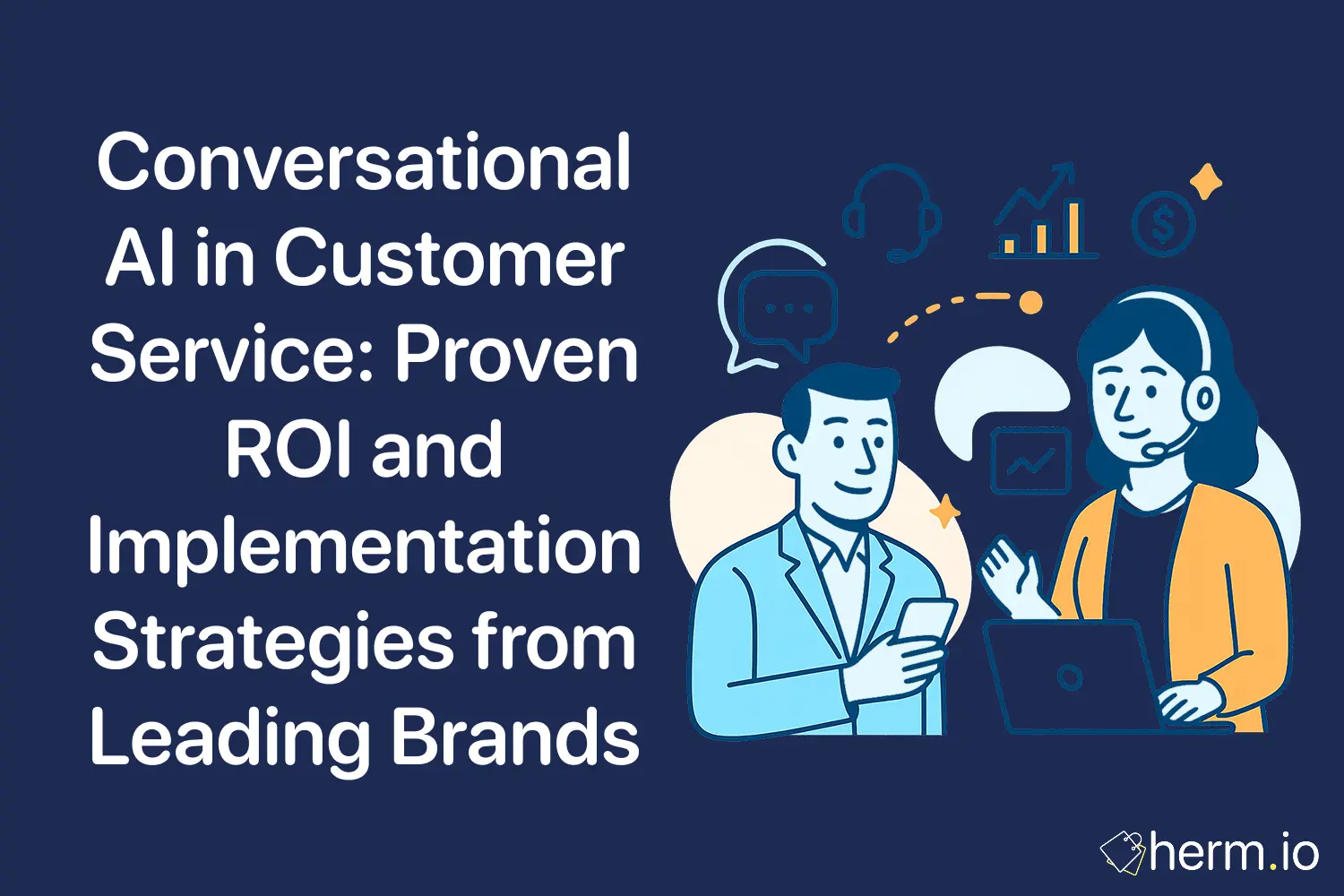
Picture this: every time you receive a perfectly tailored product recommendation, somewhere in the world, a data centre hums a little louder, consuming just a bit more electricity. What strikes me as particularly important about our current moment in marketing is how we've become so focused on the precision of personalisation that we've barely paused to consider its environmental weight.
The promise of sustainable AI personalisation isn't just a technical challenge—it's a moral one. As marketers, we find ourselves at a crossroads where our pursuit of relevance meets our responsibility to the planet. The carbon footprint of personalisation technologies has grown exponentially, yet most marketing teams remain unaware of the environmental cost embedded in every algorithmic decision, every real-time recommendation, and every perfectly timed email.
According to the United Nations Environment Programme, AI-related infrastructure may soon consume six times more water than Denmark, a country of 6 million people. When we consider that a single request made through ChatGPT consumes ten times the electricity of a Google Search, the scale of our digital environmental impact becomes impossible to ignore.
This exploration will guide you through understanding why personalisation requires environmental scrutiny, how machine learning operations generate substantial CO2 emissions, which green AI practices can reduce this impact, and whether marketing metrics should begin accounting for carbon costs alongside conversion rates. Like watching patterns emerge in nature, we'll observe how sustainable practices can actually enhance rather than hinder marketing effectiveness.
The Hidden Environmental Costs of Every Personalised Interaction
The environmental impact of AI-driven personalisation extends far beyond what most marketing professionals realise. When we examine research conducted by the Institute for Ecological Economy Research in Germany, we discover that AI applications in online marketing create substantial sustainability challenges across multiple dimensions that marketers rarely consider.
Understanding the environmental cost requires recognising what researchers describe as the "data lifecycle" approach. Every personalised interaction—from the moment a user visits your website to the delivery of a tailored recommendation—follows a predictable path that consumes energy at each stage. Data collection captures user behaviour, storage systems maintain this information across distributed servers, processing algorithms analyse patterns, and real-time systems deliver personalised content. Each stage appears minimal in isolation, yet the cumulative effect becomes substantial when multiplied across millions of daily interactions.
Research from the University of Siegen provides stark context that transforms our understanding of scale. Their comprehensive analysis reveals that a recommender systems research paper utilising deep learning algorithms emits approximately 42 times more CO2 equivalents than papers using traditional algorithms. On average, such research produces 3,297 kilograms of CO2 equivalents—more than one person produces by flying from New York City to Melbourne, or the amount one tree sequesters in 300 years.
When we translate these academic findings to commercial applications, the implications become staggering. A sophisticated personalisation system serving millions of users daily could generate carbon emissions equivalent to thousands of international flights annually, yet most marketing teams remain completely unaware of this environmental burden.
The research reveals a troubling awareness gap within marketing organisations. German interviews with marketing professionals show that while technical teams understand energy consumption concerns, this knowledge rarely influences decision-making. As one data scientist explained, "At least in my field, people know that machine learning is energy-intensive." However, another marketing manager revealed the practical reality: "In the case of consultants, it's already a lot of pressure to make these solutions for the clients because you work on an hour basis. It will never happen that someone will just work over hours just so an algorithm is more ecologically friendly."
What makes this environmental cost particularly insidious is its invisibility to the marketing teams implementing these systems. Most organisations rely on platforms like Google and Meta for personalisation services, yet these platforms provide minimal transparency about energy consumption. One marketing manager explained the frustration: "What we can influence internally, we monitor and work against it, of course. But everything that we do together with external parties—we are aware of it, of course—but there are no levers for us to prevent it."
This opacity creates a fundamental management problem: we cannot optimise what we cannot measure. The environmental cost of personalisation remains largely hidden from marketing teams, yet the cumulative impact grows exponentially as personalisation becomes more sophisticated and ubiquitous across digital experiences.
The True Scale of Machine Learning's Carbon Footprint
The scale of energy consumption in AI-driven personalisation becomes clearer when we examine specific research findings from leading institutions. Stanford University's comprehensive analysis of digital advertising infrastructure reveals numbers that should give every marketing professional pause for reflection.
Consider the seemingly simple act of browsing a website. Research from TU Berlin's automated browsing simulations discovered that the average website visit triggers 155 cookies, transferring approximately 0.2 MB of data purely for tracking and personalisation purposes. When you multiply this across the 4.5 billion monthly visits to just the top 200 German websites examined in their study, the scale transforms these seemingly insignificant amounts into massive environmental impacts.
The numbers become even more striking when we examine global patterns. The top one million most visited websites generate 197 trillion cookies monthly, resulting in over 11,000 metric tonnes of CO2 emissions. To put this in perspective, that's equivalent to the annual carbon emissions from approximately 2,400 passenger cars.
The energy intensity varies dramatically based on algorithmic complexity, and this is where modern personalisation systems reveal their true environmental cost. Deep learning algorithms used in contemporary personalisation require substantially more computational resources than traditional approaches. Research demonstrates that training a large language model—increasingly common in sophisticated personalisation engines—can produce 300,000 kg of CO2 equivalents, which equals approximately 125 round trips between New York and Beijing.
Real-time personalisation compounds these impacts through what researchers term "always-on" processing requirements. Unlike batch processing that occurs periodically, personalisation systems must respond instantaneously to user behaviour patterns. This requirement means servers cannot enter energy-saving modes, maintaining constant computational readiness that increases baseline energy consumption significantly.
Geographic location creates a multiplication effect that many marketing teams never consider. The same computational work produces vastly different environmental impacts depending on local electricity generation methods. Research shows that AI training in regions dependent on coal-fired power plants can produce twelve times higher carbon emissions than identical processes powered by renewable energy sources. This geographic disparity means that companies could potentially reduce their carbon footprint by 1,200% simply by choosing data centres in regions with cleaner electricity grids.
The measurement challenges identified across multiple research studies highlight a crucial implementation barrier: most organisations lack comprehensive visibility into their actual environmental impact. Energy consumption data remains fragmented across different service providers, making holistic carbon accounting nearly impossible for marketing teams genuinely seeking to understand their environmental footprint.
What makes these findings particularly sobering is their trajectory. As mentioned in the Stanford HAI research, the number of data centres has surged to 8 million from 500,000 in 2012, driven in part by the explosion of AI applications. This growth pattern suggests that current environmental impacts represent merely the beginning of a much larger challenge facing the marketing industry.
Practical Green AI Solutions: From Model Pruning to Edge Computing
The response to AI's environmental challenges has sparked innovation in what researchers call "green AI" practices. These approaches focus on maintaining personalisation effectiveness while dramatically reducing computational requirements and energy consumption—think of it as achieving the same marketing results with a fraction of the environmental cost.
Model pruning represents one of the most accessible and effective approaches for reducing AI's environmental impact. This technique involves systematically removing unnecessary neural network connections while preserving algorithmic performance. Picture editing a manuscript where you remove redundant words and phrases while maintaining the essential meaning and impact. Research demonstrates that properly pruned models can achieve up to 90% reduction in computational requirements while maintaining comparable personalisation accuracy.
The effectiveness of pruning often surprises marketing teams implementing these techniques. One implementation documented in the research showed a pruned recommendation system requiring only 15% of the original's computational resources while delivering 98% of the personalisation quality. This dramatic efficiency gain translated to proportional reductions in energy consumption and carbon emissions without meaningful impact on user experience or conversion rates.
Knowledge distillation offers another powerful approach that marketing teams can implement relatively easily. This process involves training smaller "student" models to replicate the behaviour of larger "teacher" models. Stanford research indicates that properly distilled models can achieve similar personalisation quality using a fraction of the computational resources. One implementation example showed a distilled model requiring only 10% of the original's energy consumption while delivering 95% of the personalisation accuracy.
Edge inference represents perhaps the most transformative approach to sustainable personalisation, though it requires more significant technical implementation. Instead of processing every personalisation decision in energy-intensive data centres, edge computing brings algorithmic processing closer to users through local devices or regional servers. The environmental benefits compound when we consider that edge processing eliminates the energy costs of data transmission while reducing server load in centralised facilities.
The German research provides concrete evidence of implementation success. Marketing teams that systematically reviewed and optimised their personalisation algorithms frequently identified opportunities for substantial energy reduction without system overhauls. One company reduced their personalisation system's energy consumption by 35% simply by removing unused features from their machine learning models and optimising data processing workflows.
Perhaps most encouraging, the efficiency gains from green AI practices often exceed expectations. Research participants consistently reported that optimised algorithms frequently perform better than their energy-intensive predecessors. As one researcher noted, "Training better models can actually save more energy over time. For example, Neural Architecture Search can find very efficient models. Given the number of times they're used each day for inference, in less than a week they save more in energy than the old hand-tuned versions."
Implementation strategies vary based on organisational technical sophistication and personalisation requirements. Companies with advanced technical teams can implement custom pruning and distillation processes tailored to their specific use cases. Organisations with limited AI expertise can adopt pre-optimised models from providers who have already implemented green AI practices, achieving immediate environmental benefits without internal development efforts.
The measurement of success in green AI requires expanding traditional marketing metrics to include environmental considerations. Click-through rates, conversion rates, and customer lifetime value remain important, but they must be evaluated alongside energy consumption and carbon emission data to provide a complete picture of algorithmic performance and sustainability impact.
Should Marketing Consider Carbon Per Conversion?
The integration of environmental metrics into marketing measurement represents a fundamental shift in how we evaluate campaign success. Research suggests that carbon-conscious marketing measurement could transform decision-making processes while potentially improving overall performance.
The concept of "carbon per conversion" emerges from research examining how marketing teams might account for environmental costs alongside traditional metrics. Just as we currently measure cost per acquisition and customer lifetime value, carbon accounting would introduce environmental impact as a standard performance indicator.
Implementation approaches vary in complexity and scope. The most straightforward method involves tracking energy consumption data from advertising platforms and converting this to carbon emissions using regional electricity grid data. Research from multiple institutions suggests that this basic carbon accounting could be implemented relatively easily for organisations with access to platform energy consumption data.
More sophisticated approaches integrate carbon costs into automated decision-making systems. The research indicates that some companies are beginning to experiment with bidding algorithms that consider environmental impact alongside financial costs. These systems might prefer advertising placements on platforms or in geographic regions with lower carbon intensity, even if the immediate financial cost appears slightly higher.
The business case for carbon accounting extends beyond environmental responsibility. Research participants noted that carbon-conscious practices often correlate with improved efficiency and reduced operational costs. One marketing manager observed: "Just as we cause emissions when we produce products, we also cause emissions when we do marketing. The hunger for energy in these systems, it's scary, isn't it?" This awareness led to optimisation efforts that reduced both environmental impact and advertising costs.
Practical implementation requires collaboration between marketing teams and technical infrastructure providers. The research reveals that most marketing teams lack direct access to the data required for carbon accounting. However, platforms like Google have begun providing carbon footprint calculation services, though these remain difficult to access and often require special permissions.
Consumer expectations increasingly include environmental considerations in brand evaluation. Research from the Institute for Ecological Economy Research found that 66% of shoppers seek out "eco-friendly" brands, while 72% believe companies overstate their sustainability efforts. This dynamic suggests that transparent carbon accounting could become a competitive advantage for marketing teams willing to measure and optimise their environmental impact.
The challenge lies in standardisation and industry adoption. Individual companies implementing carbon accounting create limited impact unless industry-wide measurement standards emerge. Research suggests that regulatory pressure may eventually mandate environmental disclosure for digital marketing activities, making early adoption of carbon metrics a strategic advantage.
Measuring Environmental Impact Across Personalisation Systems
Understanding the environmental footprint of personalisation requires systematic measurement approaches that capture both direct and indirect impacts. Research from multiple institutions provides frameworks for comprehensive environmental assessment that marketing teams can adapt to their specific needs.
Direct environmental impacts encompass the immediate energy consumption of AI systems throughout their lifecycle. The research identifies three primary stages: data collection and transmission, model training and optimisation, and real-time inference during personalisation delivery. Each stage contributes differently to overall environmental impact, with training typically representing the largest single carbon emission event, while inference creates ongoing environmental costs.
The measurement complexity increases when considering what researchers term "scope 3" emissions—indirect environmental impacts that occur throughout the personalisation supply chain. These include the manufacturing of hardware components, the extraction of rare earth elements required for semiconductors, and the eventual disposal of electronic waste from data centre equipment. Research suggests that scope 3 emissions can represent 60% or more of the total environmental impact, yet they remain largely unmeasured in current marketing practices.
Practical measurement approaches range from simple estimations to comprehensive lifecycle assessments. The most accessible method involves using platform-provided energy consumption data combined with regional carbon intensity factors. Research participants successfully implemented basic carbon tracking using this approach, though data availability remains inconsistent across different advertising and personalisation platforms.
More sophisticated measurement requires collaboration with technical teams to implement custom monitoring systems. The research describes implementations where companies integrated energy monitoring directly into their personalisation algorithms, creating real-time visibility into environmental costs alongside performance metrics. These systems enable optimisation based on environmental criteria, potentially improving both sustainability and efficiency.
Industry benchmarking emerges as a crucial component of effective measurement. Research suggests that environmental impact varies dramatically across different personalisation approaches, with some techniques producing 40 times higher carbon emissions than alternatives while delivering similar marketing outcomes. Understanding these benchmarks helps marketing teams make informed decisions about technology selection and implementation approaches.
The standardisation challenge affects measurement credibility and comparability. Research participants noted that without industry-standard measurement methodologies, environmental claims become difficult to verify and compare. However, early adopters gain competitive advantages by developing internal expertise and measurement capabilities before industry standards emerge.
Implementation Strategies for Sustainable Personalisation
Translating environmental awareness into practical action requires structured approaches that balance sustainability goals with marketing effectiveness. Research from organisations successfully implementing sustainable personalisation provides roadmaps that other marketing teams can adapt to their circumstances.
The most successful implementations begin with comprehensive auditing of existing personalisation systems. Research participants who achieved significant environmental improvements started by cataloguing all AI-powered marketing activities, identifying their computational requirements, and measuring baseline energy consumption. This audit process often reveals opportunities for immediate improvement without requiring major system changes.
Technical optimisation strategies focus on algorithmic efficiency improvements. Research demonstrates that systematic review of personalisation algorithms frequently identifies opportunities for substantial energy reduction. One company reduced their personalisation system's energy consumption by 35% simply by removing unused features from their machine learning models and optimising data processing workflows.
Platform selection considerations increasingly include environmental criteria alongside functional requirements. Research suggests that marketing teams can significantly influence their environmental impact through vendor selection decisions. Platforms powered by renewable energy or operating in regions with clean electricity grids provide immediate carbon reduction opportunities without requiring internal technical changes.
The implementation timeline affects both environmental impact and business outcomes. Research indicates that gradual implementation approaches tend to achieve better long-term results than rapid wholesale changes. Successful organisations typically begin with pilot programmes focused on specific personalisation use cases, measure the environmental and performance impacts, then scale successful approaches across broader marketing activities.
Stakeholder engagement proves crucial for sustainable implementation success. Research participants emphasised the importance of securing leadership support for environmental initiatives while demonstrating clear business benefits. Marketing teams that framed sustainability as an efficiency and cost reduction opportunity gained more organisational support than those focusing solely on environmental responsibility.
Training and capability development requirements vary based on organisational technical sophistication. Research suggests that marketing teams need basic literacy in AI energy consumption concepts to make informed decisions about sustainable personalisation approaches. However, deep technical expertise typically requires collaboration with engineering teams or external specialists.
Future Directions in Sustainable AI Marketing
The trajectory of sustainable AI personalisation points toward increasingly sophisticated approaches that automatically balance environmental impact with marketing effectiveness. Research across multiple institutions suggests several emerging trends that will reshape how marketing teams approach personalisation in the coming years.
Automated optimisation systems represent the most promising development for mainstream adoption of sustainable personalisation. Research indicates that AI systems can be trained to consider carbon emissions as an optimisation objective alongside traditional marketing metrics. These systems would automatically select lower-impact personalisation approaches when environmental costs exceed predefined thresholds or when multiple approaches deliver similar marketing outcomes.
Regulatory developments increasingly influence sustainable AI adoption. Research from European institutions suggests that environmental disclosure requirements for digital marketing activities may become mandatory within several years. Early adopters of carbon measurement and optimisation systems will be better positioned to comply with emerging regulations while competitors struggle to implement measurement capabilities.
The democratisation of green AI tools continues reducing implementation barriers for marketing teams. Research participants noted that cloud platforms increasingly offer pre-optimised AI models and automated carbon tracking capabilities. These developments enable organisations without deep technical expertise to implement sustainable personalisation practices without significant internal development efforts.
Industry collaboration initiatives show promise for addressing measurement standardisation challenges. Research suggests that marketing platform providers are beginning to collaborate on environmental impact measurement standards, potentially creating industry-wide carbon accounting capabilities within the next few years.
Consumer awareness and expectations continue driving market demand for transparent environmental practices. Research indicates that brands implementing visible sustainable personalisation practices gain competitive advantages, particularly among environmentally conscious consumer segments. This dynamic creates positive feedback loops that accelerate sustainable practice adoption across the marketing industry.
We have a responsibility to acknowledge that sustainable AI personalisation represents both a technical challenge and an ethical imperative. The research demonstrates that environmental consciousness in marketing need not compromise effectiveness—indeed, the most successful sustainable implementations often deliver improved performance alongside reduced environmental impact.
Frequently Asked Questions
What's the actual carbon footprint of a typical personalisation campaign?Research indicates substantial variation based on algorithmic complexity and scale. A deep learning-powered personalisation system can produce approximately 42 times more CO2 emissions than traditional approaches. For perspective, training a sophisticated personalisation model might generate 300,000 kg of CO2 equivalents—equivalent to 125 round trips between New York and Beijing. However, smaller-scale implementations using optimised algorithms can reduce these emissions by 90% or more while maintaining comparable performance.
How can marketing teams measure their AI environmental impact without technical expertise?Start with platform-provided energy consumption data where available, then apply regional carbon intensity factors to estimate emissions. Many cloud providers now offer carbon footprint calculation services, though access may require special requests. For basic measurement, focus on tracking computational hours used by personalisation systems and multiply by average data centre energy consumption rates. While not perfectly precise, this approach provides sufficient accuracy for initial optimisation efforts.
Do green AI practices actually compromise personalisation effectiveness?Research consistently demonstrates that optimised AI systems often perform better than their energy-intensive counterparts. Model pruning and knowledge distillation techniques typically maintain 95% or higher personalisation accuracy while reducing energy consumption by 80-90%. The optimisation process frequently reveals and eliminates inefficiencies that improve both environmental impact and response times. Early implementations sometimes show temporary performance reductions, but systematic optimisation usually surpasses original effectiveness levels.
What's preventing widespread adoption of sustainable personalisation practices?The primary barriers include lack of visibility into environmental costs, absence of industry measurement standards, and organisational prioritisation of short-term performance over long-term sustainability. Research reveals that most marketing teams lack access to the data required for carbon accounting, while platform providers often don't offer transparent environmental impact information. Additionally, the perceived complexity of implementation deters organisations without dedicated technical resources.
How will environmental regulations affect AI marketing practices?Research suggests that mandatory environmental disclosure for digital marketing activities will likely emerge within the next five years, particularly in European markets. Companies implementing carbon measurement and optimisation systems now will be better positioned for regulatory compliance while competitors face implementation pressures. Early adoption provides competitive advantages in environmentally conscious markets while building organisational capabilities for future regulatory requirements.
References and Further Reading
Research Materials Used:
- AI-Driven Personalization in Advertising: Transforming Consumer Engagement through Sustainability and Circular Economy - This academic paper provided foundational insights into the environmental impacts of AI-powered advertising systems, particularly the case study analysis of major brands like Patagonia, IKEA, and Adidas implementing sustainable advertising practices. The research detailed the energy consumption patterns of AI-driven personalisation systems and their cumulative environmental effects.
- From Clicks to Carbon: The Environmental Toll of Recommender Systems - This comprehensive study from the University of Siegen offered crucial quantitative data on the carbon emissions of AI systems, including the finding that deep learning algorithms emit 42 times more CO2 than traditional approaches. The research provided specific measurements of energy consumption across different algorithmic approaches and hardware configurations.
- The (Un-)Sustainability of Artificial Intelligence in Online Marketing - The Institute for Ecological Economy Research study contributed detailed analysis of the broader sustainability challenges in AI-powered marketing, including survey data from German companies and consumers. This research provided insights into implementation barriers and stakeholder perceptions of sustainable AI practices.
- Reducing your digital carbon footprint - Google's industry perspective offered practical examples of how companies like EDF achieved 17% cost reductions and 13% emission decreases through optimised AI-powered advertising systems. This material provided real-world implementation strategies and measurable outcomes.
- Sustainability and AI (Stanford HAI Industry Brief) - Stanford University's comprehensive analysis detailed emerging applications of AI in sustainability across multiple sectors, providing context for how environmental considerations are being integrated into AI system design and deployment.
- AI has an environmental problem (UNEP) - The United Nations Environment Programme assessment provided regulatory and policy context for sustainable AI development, including recommendations for standardised environmental impact measurement and disclosure requirements.

Isla Penelope Brooks
I'm a British data storyteller and analytics specialist based in Munich. As a Technical University of Munich graduate, I transform complex data into meaningful insights. I'm passionate about equity in data and believe in the responsibility that comes with shaping what people see and think through marketing.

.png)








.png)

.png)
.png)
.png)